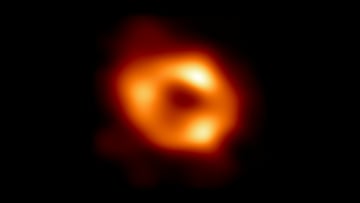Supermassive black hole: first image of Sagittarius A* revealed
A worldwide network of scientists known as the Event Horizon Telescope Collaboration has released the first ever image of the supermassive black hole at the centre of our galaxy.

Astronomers have produced the first ever image of Sagittarius A*, the supermassive black hole long thought to exist at the centre of the Milky Way, our home galaxy. The historic image of the black hole, known for short as Sgr A*, was released on Thursday by the Event Horizon Telescope (EHT) Collaboration, a global network of scientists comprising over 300 researchers and 80 institutes.
The EHT Collaboration used an array of telescopes around the world to create a virtual ‘Earth-sized’ telescope, whose name, Event Horizon, refers to the entrance to a black hole. The EHT combined data collected at each location to produce an image that is the average of thousands of images taken of Sgr A*.
How far away is Sgr A*? How big is it?
Located about 27,000 light years away from Earth, Sgr A* has a mass four million times that of our Sun and has a diameter of around 60 million kilometres - about a third of the distance between Earth and the Sun. While we cannot see the black hole itself, the image released on Thursday offers up a “telltale signature” pointing to its presence, the EHT Collaboration said in a statement: “a dark central region (called a ‘shadow’) surrounded by a bright ring-like structure”.
What exactly is a black hole?
A black hole is an area in space where gravity is so strong that nothing can escape from it - not even light, which travels faster than anything else in our universe. Because light cannot be released from inside a black hole, it is impossible to see beyond the threshold to a black hole without entering it yourself. That’s why the boundary is known as the event horizon.
While scientists have established a firm understanding of how low-mass black holes are formed - essentially, this occurs when a star collapses in on itself - it remains less clear how supermassive black holes such as Sgr A* are formed.
“Overwhelming evidence the object is indeed a black hole”
Experts have believed for decades that there is a black hole at the centre of the Milky Way, but this is the first visual proof to back this up. “This result provides overwhelming evidence that the object is indeed a black hole and yields valuable clues about the workings of such giants, which are thought to reside at the centre of most galaxies,” the EHT Collaboration said.
Sgr A* is the second black hole the team has successfully pictured. In April 2019, the EHT Collaboration released the first ever image of a black hole: M87*, located at the centre of the Messier 87 galaxy, some 55 million light years from Earth. More than a thousand times bigger and more massive than Sgr A*, M87* actually proved easier to capture, despite being far further away.
“Like taking a clear picture of a puppy chasing its tail”
“The gas in the vicinity of the black holes moves at the same speed - nearly as fast as light - around both Sgr A* and M87*,” EHT scientist Chi-kawn Chan explained. “But where gas takes days to weeks to orbit the larger M87*, in the much smaller Sgr A* it completes an orbit in mere minutes. This means the brightness and pattern of the gas around Sgr A* was changing rapidly as the EHT Collaboration was observing it - a bit like trying to take a clear picture of a puppy quickly chasing its tail.”
The EHT Collaboration’s findings are to be published on Thursday in a special issue of The Astrophysical Journal Letters.






